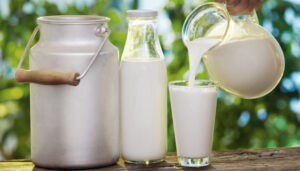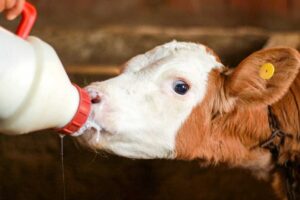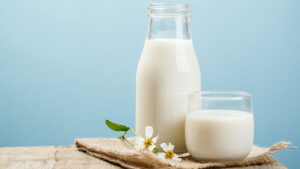
Prices for extra-virgin milk in Ukraine in January 2025 decreased by 8% to 18.5 UAH/kg compared to December 2024, according to the Union of Dairy Enterprises of Ukraine (UDEP).
Analysts noted that milk prices in January 2025 were 23% higher than in January 2024 and 33% higher than in June 2024.
At the same time, the growth rate of raw milk prices in Ukraine (in UAH) in the second half of 2014 was 2.3 times higher than in the EU (in EUR – 1.8 times). The average price in January 2025, expressed in EUR (for the domestic quality basis), amounted to almost EUR 42.7/100 kg – compared to EUR 45.7/100 kg in December 2024 and EUR 44.7 in November 2024.
“The price in EUR decreased by almost 7% compared to December 2024, and by 5.5% compared to November 2024. At the same time, the price increased by 34% compared to June 2024; by 18.5% compared to January 2024. The average price, expressed in euros and converted to the euro base, decreased to EUR47.3/100 kg in January 2024 – from almost EUR51/100 kg in December 2024,” the UMPA stated.
The experts drew attention to the fact that the ratio between the price levels in Ukraine and the EU/Poland in January 2024 was 87% to the EU average and 82.5% to the Polish average.
“The respective ratios have “rolled back” to the level of October 2024 – the competitiveness of domestic dairy products has increased in January 2025,” the industry association summarized.

In January, Ukraine increased imports of dairy products by 55% compared to the same period last year, Infagro news agency reported.
“The market of fresh dairy products began to revive in February. Sales growth is rather slow, there is no positive dynamics that was observed in the same period of previous years. In February, prices began to stabilize, but unfortunately, by this time they had already reached a very high level,” analysts said.
Experts suggested that in order to stimulate sales, it would be right to reduce prices, especially for sour cream and cottage cheese. Therefore, the major players will try to resort to promotional sales with significant price reductions more often in the near future. In any case, there should definitely be no further price increases, they believe.
“Domestic producers should already be concerned about a significant increase in imports of fresh dairy products. In January, they were imported by 55% more than in the same period last year. And if earlier Ukraine mainly imported yogurt and various cheese products, in January several hundred tons of cheap Polish milk were imported. Polish imports of fresh dairy products accounted for 60% of the total volume,” the industry publication emphasized.
Exports of fresh dairy products are also growing, but not at the same rate as imports. The main export market for Ukrainian fresh dairy products remains Moldova, 88%, Infagro summarized.

Prices for raw milk in Ukraine declined in early January due to a decrease in demand from dairy processing companies during the New Year holidays, the Association of Milk Producers (AMP) reported.
The industry association noted that the average purchase price of extra milk as of January 6 was 19.10 UAH/kg excluding VAT, which is 0.60 UAH less than a month earlier, while the price of premium milk was 18.35 UAH/kg excluding VAT (-0.35 UAH), and the price of first grade remained unchanged at 17.65 UAH/kg excluding VAT. The weighted average price of the three milk grades was fixed at 18.37 UAH/kg excluding VAT, which is 0.32 UAH less than in December.
“The decline in raw milk prices in Ukraine at the beginning of the year led to a drop in butter prices. A drop in consumer activity in the market is also traditionally observed during the New Year holidays. In addition, Ukrainian companies reduced the volume of butter exports in December due to lower prices for the product on foreign markets. (…) The domestic market has seen a surplus of raw milk, and maximum prices for extra and premium milk have gone down due to reduced demand from dairy processing companies,” explained AVM analyst Giorgi Kukhaleishvili.
The AMP reported that Ukraine is also experiencing a decline in butter prices, coupled with a halt in the growth of prices for fermented dairy products due to limited purchasing power of the population and reduced demand for dairy products in the domestic market. Due to high prices for domestic dairy products, imports of processed dairy products, including cheese, increased in December.
“A significant reduction in purchase prices in Ukraine is unlikely due to the increase in the cost of milk production due to rising feed costs and the need to meet EU environmental requirements,” the industry association said.
It is likely that in 2025 the global dairy market will move to a new price corridor – from $40 to $50 per 100 kg of raw milk. In 2024, the average price of raw milk in Ukraine was $42.45 per 100 kg, which is 20% higher than in 2023. The price of raw milk in Ukraine grew throughout 2024, unlike in the EU, the US and New Zealand. In 2025, the average milk price in Ukraine is likely to increase to $45-46 per 100 kg of raw milk. In the absence of force majeure, a certain decrease in purchase prices is likely in late April – early May this year as a result of a seasonal increase in milk production in households, the AMP predicts.

In 2024, commercial dairy farms will increase milk supplies for food processing by 6% compared to last year, said Anna Lavreniou, CEO of the Association of Milk Producers (AMP), at the international conference “Opportunities and Challenges of European Integration of Livestock in Moldova and Ukraine” at the EuroTier-2024 exhibition in Germany.
“The war brought terrible losses. Today, more than 100 dairy farms in Ukraine have been either destroyed or destroyed due to Russia’s terror tactics. Restoration of these facilities is critical to ensure stable milk production. At the same time, despite the active phase of the war, industrial dairy farms continue to invest in productivity, compliance with European standards, and safety,” she said.
Lavreniuk emphasized that in 2024, Ukrainian dairy farms will increase milk supplies for food processing by 6%.
In addition, the head of the industry association noted the accelerated pace of innovation in practice, which was catalyzed by the war.
“Our Ukrainian producers are investing in biogas plants at a frantic pace to provide themselves and their communities with electricity. This is a new challenge that requires technical expertise and financial support,” noted Lavreniuk.
According to her, Ukraine is currently experiencing not a staff shortage, but a staff famine.
“The huge turnover of personnel in the agricultural sector requires express training and professional development courses and their adaptation to European requirements. This is the number one challenge, because we don’t have time,” stated the head of the AUFM.
Lavreniuk also asked her European colleagues not to get tired of providing financial assistance to Ukrainian farmers who need support for recovery and development, which involves investing in new technologies and modernizing production processes.

The increase in raw milk prices in the second half of November was due to the growing interest of European traders in domestically produced butter, but the decline in demand for dairy products in the domestic market may stabilize prices in the second half of December, according to the Association of Milk Producers (AMP).
According to analysts, as of November 20, the average purchase price of extra milk increased by 1 UAH/kg to 19.40 UAH/kg excluding VAT, the price of premium milk increased by 1.20 UAH/kg to 18.65 UAH/kg excluding VAT, and the price of first-class milk increased by 1 UAH/kg to 17.7 UAH/kg.
Accordingly, the weighted average price of the three varieties amounted to 18.58 UAH/kg excluding VAT, which is 1.07 UAH more than a month earlier.
AVM analyst Giorgi Kukhaleishvili noted that another increase in raw milk prices in Ukraine was caused by the increased demand for butter in foreign markets in November.
“As the price of New Zealand butter rose to $7 thousand/ton, European traders started to turn to Ukrainian producers with a desire to buy butter at more attractive prices. After a slight decline in demand for exchange-traded products at the beginning of the month, there is now an increase in interest in butter and cheese on foreign markets,” the expert explained.
At the same time, the AMP points to a decrease in demand for raw milk from Ukrainian dairy processing enterprises in November compared to September-October. At the same time, the growth rate of purchase prices is gradually slowing down due to a decrease in consumer demand for dairy products in the domestic market.
“Ukrainian consumers with below-average incomes have started to deny themselves dairy products due to rising prices not only for dairy products but also for other food products. Consumption of spreads is growing in the country as a cheaper alternative to butter,” the industry association stated.
The growth of raw milk prices is constrained by high prices for finished products and the difficulty of selling them to consumers in the domestic market. Under such conditions, a slight increase in purchase prices is possible in early December with the prospect of further stabilization in the second half of the month, the AMP predicts.

The price of milk in Ukraine has risen by UAH 2, or 15%, since the beginning of July and will continue to rise in September, according to Infagro, an industry analytical agency.
“This scale of price increase is unprecedented for the Ukrainian raw materials market. And this is not the limit of price growth. In September, analysts predict a further increase in milk prices,” the analysts said.
They cited market changes, shortages of raw materials and rising costs due to limited energy supply as the reasons for the significant rise in the price of milk and dairy products.
Experts also noted that in the second half of August, hot weather set in again, which did not allow cattle to recover from the abnormal July heat. Cow productivity did not increase. The seasonal decline in milk production also contributed to the problem. At the same time, demand for raw materials increased, which led to a further significant rise in milk prices. In the last week of August, the problem of energy supply became more acute due to another hostile shelling.
In addition, in July, both the number of cows and milk production decreased significantly. Analysts cited data from the Ministry of Agrarian Policy and Food, according to which, as of August 1, 2024, 1 million 255.4 thousand cows were kept in the private and industrial sectors of Ukraine, which is 7% less than a year ago. In agricultural enterprises, the number of cows decreased by 2%, to 380 thousand. The statistics for August are not better, according to the analytical review.
“Given the high cost of raw materials and the influence of other factors, dairy products are becoming more expensive. And if prices for finished dairy products are growing slowly, the cost of exchange goods has increased quite quickly and significantly,” Infagro summarized.